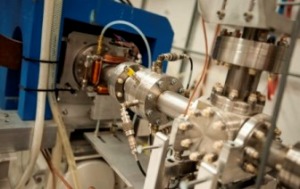Jul 30 2014
Idaho State University’s Idaho Accelerator Center has achieved a milestone in nuclear medicine that promises hope to cancer patients. Scientists at the Center have used linear accelerators to produce isotopes that now can be assessed in the treatment of cancer.
 Accelerator Medical Isotopes
Accelerator Medical Isotopes
Furthermore, ISU has received a production license from the Nuclear Regulatory Commission to use nuclear accelerators to produce the isotope copper-67, which has the potential to be more effective than chemotherapy or external radiation for the treatment of some cancers.
“We will be the only university in the western United States with a production license to produce this type of cancer-fighting isotope using e-LINAC accelerators,” said Howard Grimes, vice president for research. “The potential medical and commercial implications of producing these isotopes are huge as is the potential to add to our array of cancer fighting treatments.”
The announcement was made July 28 at the Idaho National Laboratory Meeting Center in Idaho Falls, where representatives from ISU, Idaho Department of Commerce, and International Isotopes were on hand prior to the Leadership in Nuclear Energy Commission 2.0 meeting.
“This is a big step forward in our research and allows us to produce and ship isotopes that may someday be used for a variety of medical diagnoses and treatments, including for the treatment of certain cancers,” said Jon Stoner, director of technical operations at the Idaho Accelerator Center. “Our first product is copper-67 which will go to researchers for drug development in several major medical centers in the U.S.”
ISU is partnering with an Idaho Falls company, International Isotopes, to distribute the copper-67 produced at ISU to major cancer research centers.
“This project is an outstanding example of public – private partnerships between universities and the private sector,” Grimes said. “Without these partnerships, the research would stay inside the university.”
Steve Laflin, the chief executive officer of International Isotopes, said that some important studies using the copper-67 isotope have been halted in the past because of a lack of a reliable supply of this important isotope in the United States.
“International Isotopes has partnered with ISU to help ensure that we establish reliable production processing and distribution capabilities that will be critical to support patent studies in the future,” Laflin said.
“International Isotopes is very familiar with the logistical and regulatory challenges associated with commercial distribution of short-lived radioactive materials and we look forward to working with ISU to bring this important isotope to the market.”
The development of the nuclear accelerator-produced medical isotopes would not have been possible without support from a $670,000 grant in 2012 to the ISU Accelerator Center from the Higher Education Research Council Idaho Global Entrepreneurial Mission (IGEM). This HERC IGEM grant is funded through the Idaho State Board of Education and funds from it were used on the medical isotopes project.
“Nuclear medicine is an exciting opportunity for our state’s economy,” said Commerce director Jeff Sayer. “With our state’s expertise in the nuclear industry – combined with world-class companies and research capabilities – we have the potential to not only create jobs and stimulate business, but more importantly to potentially save lives.”
The ISU Idaho Accelerator uses electron accelerators to produce the copper-67, which has the potential to be used in the future to treat people now suffering from a variety of cancers including non-Hodgkin’s Lymphoma as well as bladder, colorectal, and ovarian cancers, Stoner said. ISU has a strong team of scientists and engineers, led by Dr. Alan Hunt, doing this ground-breaking research.
Any drugs that result from the initial work by the cancer research center using the IAC-produced copper-67 will go through FDA testing and approval – typically an eight year or longer process.
Making copper-67 takes many steps, but the conversion of zinc into copper first uses a high-powered electron linear accelerator. An electron accelerator speeds up electrons, an elementary particle, to nearly the velocity of light. The researchers put the element zinc and a “converter” in the sights of the new accelerator. The accelerator, in turn, shoots electrons into the converter, a material that creates another high-energy particle – a photon. That photon travels into the zinc atoms and knocks out a proton, producing copper-67.
Copper-67 is a relatively unique isotope because it emits a particle that can kill cancer cells and a gamma ray that can be used to show doctors where the cancer is located in a patient. Copper-67 is able to do these two beneficial actions simultaneously when it is bonded with monoclonal antibodies, which basically are proteins that are created to attach to the cell walls of cancer cells.
When injected, the antibodies and copper-67 together travel down the bloodstream, find cancers cells and attach to them. The copper-67 then decays, killing the cancer cell, and emitting a gamma ray that shows the physicians exactly where the tumor is located.